Over the past years, Software as a Service (SaaS) companies have
While there are many SaaS companies out there, not all have experienced exceptional growth. In this article, we will explore the fastest growing SaaS companies and the growth tactics they employed.
| Key Element | Description | Tips for Optimization |
|---|---|---|
| Understanding the SaaS Business Model | SaaS firms offer software via subscription, focusing on scalability, flexibility, and updates. | Focus on continuous enhancements and user-centric features to stay competitive. |
| Profiling the Fastest Growing SaaS Companies | Rapidly growing SaaS firms like Typeform and Shopify use strategies such as product-driven growth and viral marketing. | Analyze these models and adapt similar tactics for your market and product. |
| Common Growth Tactics | Top SaaS companies employ feedback loops, effective marketing, and retention strategies for growth. | Leverage customer feedback in product development and diverse marketing strategies for growth enhancement. |
| Challenges | Challenges include scaling support, maintaining quality during expansion, and ensuring data security. | Invest in scalable support, continuous quality checks, and robust security measures. |
| Future Trends | Trends involve AI and ML integration, focusing on personalization, automation, and data-driven decisions. | Invest in tech advancements and adapt to market shifts that leverage these trends. |
Understanding the SaaS business model
🌐 The SaaS business model revolves around providing software solutions to customers via the internet. Instead of selling licenses or physical copies, SaaS companies offer their products on a subscription basis.
This approach offers several advantages, including scalability, flexibility, and lower upfront costs for customers. By understanding the intricacies of the SaaS business model, companies can harness its potential for exponential growth.
One advantage of the SaaS model is the ability to provide regular updates and new features to customers seamlessly. This ensures that customers have access to the latest technology and innovations without the need for manual updates or installations.
Additionally, SaaS companies can gather valuable data on how customers use their software, enabling them to make data-driven decisions to enhance the user experience further.

Key components of a successful SaaS company
A successful SaaS company comprises various key components that contribute to its growth. These include:
- A robust product
- Effective marketing strategies
- Excellent customer support
- A focus on customer retention
By excelling in these areas, SaaS companies are better equipped to scale their operations and drive sustainable growth.
Another critical component of a successful SaaS company is a strong emphasis on data security and compliance. As SaaS solutions often involve handling sensitive customer data, maintaining robust security measures and ensuring compliance with regulations such as GDPR and HIPAA is paramount.
By prioritizing data security, SaaS companies can build trust with customers and differentiate themselves in a competitive market.
The importance of growth in SaaS businesses
Growth is the lifeblood of any SaaS company. Rapidly expanding customer bases, increasing revenues, and market dominance are all indicators of growth. Fueling this growth requires a strategic approach that involves implementing effective growth tactics.
By ensuring consistent growth, SaaS companies can attract investors, secure funding, and emerge as industry leaders. Furthermore, sustainable growth in SaaS businesses often involves expanding into new markets or verticals to tap into additional revenue streams.
This diversification strategy reduces reliance on a single market and opens up opportunities for innovation and product development. This way, SaaS companies can stay ahead of the competition and adapt to evolving market trends.

Profiling the fastest growing SaaS companies
Let's analyse some of the fastest growing SaaS companies and the growth tactics they employed to achieve their success. As we are about to see, their success is a result of strategic marketing techniques, innovation, and customer-centric approaches.
These companies have set themselves apart by understanding their target market, adapting to changing trends, and staying ahead of the competition.
Typeform
Since its inception, it has served over 125,000 paying customers and 500 million digital interactions. This led to $70m ARR in 2021 (OpenView).
The founders, David Okuniev and Robert Muñoz, initially sparked interest through a teaser video that captured the unique experience of using Typeform. This early glimpse into the product quickly went viral, amassing thousands of sign-ups for the beta release.
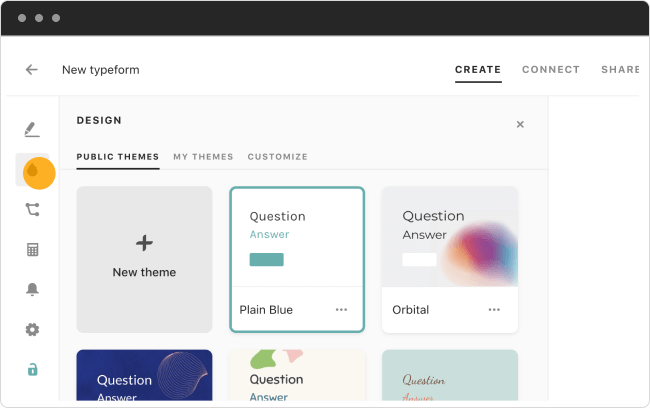
(Source: Windward Studios)
Casual contact loops
One key factor propelling the company's growth is the "Powered by Typeform" button at the end of each form. Also known as a casual contact loop, this strategy acts as a constant advertisement for the platform. This is because is subtly encourages others to sign up and create their own forms.
This feature is instrumental in turning every form created by a user into a potential viral loop, promoting organic growth without direct marketing efforts. As users consciously or subconsciously notice the product, they are more likely to return to it to create their own surveys.
This approach is central to many SaaS products that use the product itself as the main driver of user acquisition and retention, another example being the video-recording platform Loom.

(Source: Typeform)
Organic viral loops
Typeform's growth is also amplified by focusing on enhancing user experience and minimizing barriers to sharing. Like other successful tools such as Calendly and Slack, Typeform's product requires interaction between multiple users - anyone who fills out a form potentially becomes a new user.
This design inherently supports the rise of organic viral loops, as each shared form invites more users to engage with the product, many of whom will go on to create and share their own Typeform forms.
As Typeform has scaled, the company continues to refine these loops and expand its strategy to include more direct marketing and customer success initiatives, but the essence of their growth remains tied to the casual, almost effortless way users can introduce others to the product.
This strategy lowers customer acquisition costs but also builds a strong, organic user base that can sustain growth over the long term.

(Source: Typeform)
Incentivized viral loops
Moreover, Typeform leverages incentivized word-of-mouth loops through its user referral program, powered by Cello. By enabling each user of the platform to generate unique referral links and earn rewards for bringing new customers to Typeform, the virality of the product is amplified, further accelerating growth.

(Source: Typeform)
Typeform's approach exemplifies the power of integrating product functionality with virality, where every user interaction can lead to new users and deeper engagement, creating a self-sustaining cycle of growth.
Shopify
Shopify, an e-commerce platform, has rapidly grown since its inception. Over 2 million merchants sell using Shopify, and the company made $7bn in revenues in 2023 alone. Its growth can largely be attributed to its robust marketing strategies that cleverly integrate both traditional and innovative digital marketing approaches.
At the core of Shopify's growth strategy are paid ad loops, alongside effective use of content marketing, social media engagement, and an emphasis on user-friendly features and constant innovation.

(Source: Forbes)
Paid advertising loops
Shopify strategically uses paid advertising to draw in new users and convert them into customers. These advertising campaigns are designed to showcase the platform’s ease of use and wide range of features, appealing directly to small business owners and entrepreneurs looking to establish an online presence quickly and efficiently.
By reinvesting revenues into additional advertisement campaigns, Shopify further boosts its visibility in different markets and reaches new audiences, further increasing its growth.

Content marketing and social media
Shopify has also heavily invested in content marketing, creating a wide array of resources that support their users' journeys. This includes educational blogs, how-to guides, and success stories, all aimed at helping users understand and make the most of the platform.
By consistently delivering valuable content, Shopify not only boosted its SEO efforts but has also established itself as a thought leader in the e-commerce space.
The role of social media in Shopify's strategy is significant. With strong presences on platforms like Facebook, Instagram, and YouTube, Shopify tailors its content to each platform, maximizing engagement and reach.
This broad social media footprint helps to drive both direct and referral traffic to their website, further enhancing their market visibility and user acquisition.
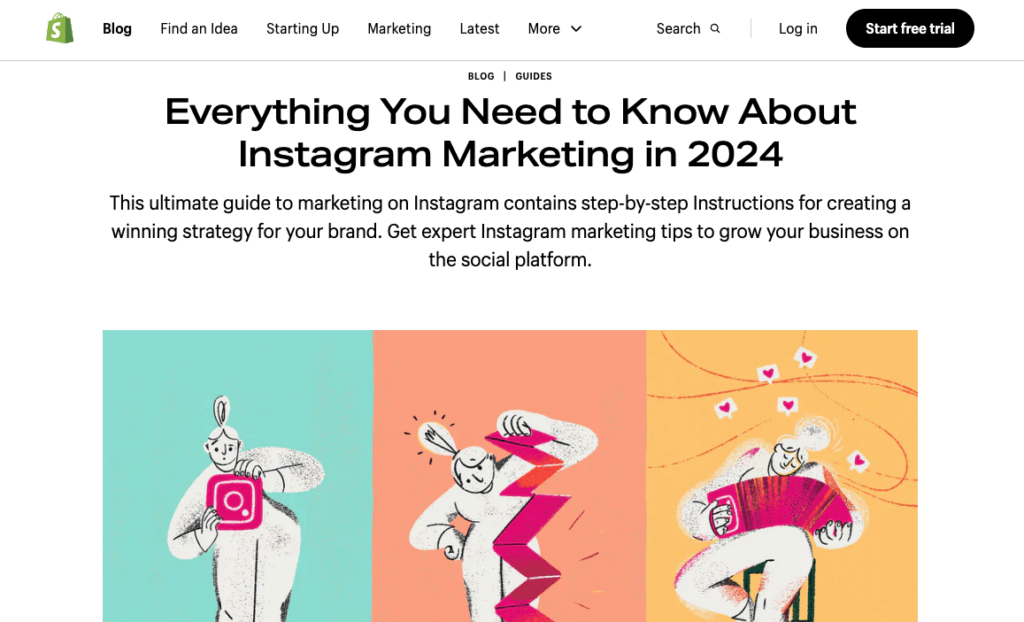
(Source: Shopify)
User experience
A key aspect of Shopify's appeal is its user-friendly design, which simplifies the process of setting up an online store. Features like the mobile management app and social media integrations make it easier for store owners to manage their businesses on the go and market their products across different platforms.
Innovative campaigns
Shopify frequently uses innovative marketing campaigns, such as the "Build a Business" competition. Such initiatives drive user engagement and new sign-ups while solidifying Shopify’s reputation as a supportive platform for emerging businesses.
These strategies, combined with a focus on continuous improvement and feature upgrades, have enabled Shopify to rapidly expand its user base and maintain a dominant position in the e-commerce industry.
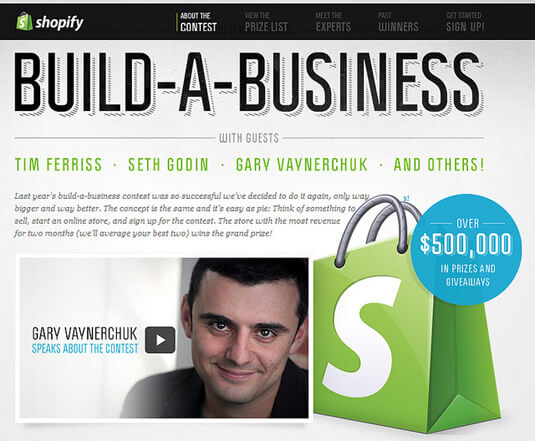
(Source: Shawn Graham)
Each element of their strategy interlinks to form a comprehensive approach to growth, leveraging paid and organic channels to maximize reach and conversion.
DocuSign
DocuSign is an electronic signature provider. Over the past years, it has witnessed impressive growth. While some of this can be attributed to social distancing and remote work during the pandemic, when DocuSign grew by over 49%, it has continued a very positive trajectory, reaching $2.8bn in fiscal 2024 revenue (The Motley Fool).
This growth resulted from a combination of strategic product differentiation and sales growth loops, including investing profits back into its reseller channels. Moreover, DocuSign's ability to spearhead the digital transition of signatures during the pandemic enabled it to reap the rewards from the sector's expansion.
The company's strategy centers around offering a distinct value proposition and leveraging their market position to not just sell directly, but also widen their reach through partnerships and reseller programs.

Product differentiation
DocuSign's product differentiation strategy is fundamental to its success, particularly in how it stands out in the competitive electronic signature market.
The company focuses on creating specific use cases for various industries, which helps businesses see exactly how DocuSign can solve their unique problems.
This tailored approach makes the product relevant across different sectors, from legal to HR to sales, providing clear, practical applications of their technology. This improves user engagement and boosts SEO by driving traffic to these specialized pages.
Moreover, DocuSign has expanded into other verticals, including identity verification, contract creation and management, and payment. This has enabled it to cross-sell its products, capturing a market share across different areas and appealing to a wider user base.
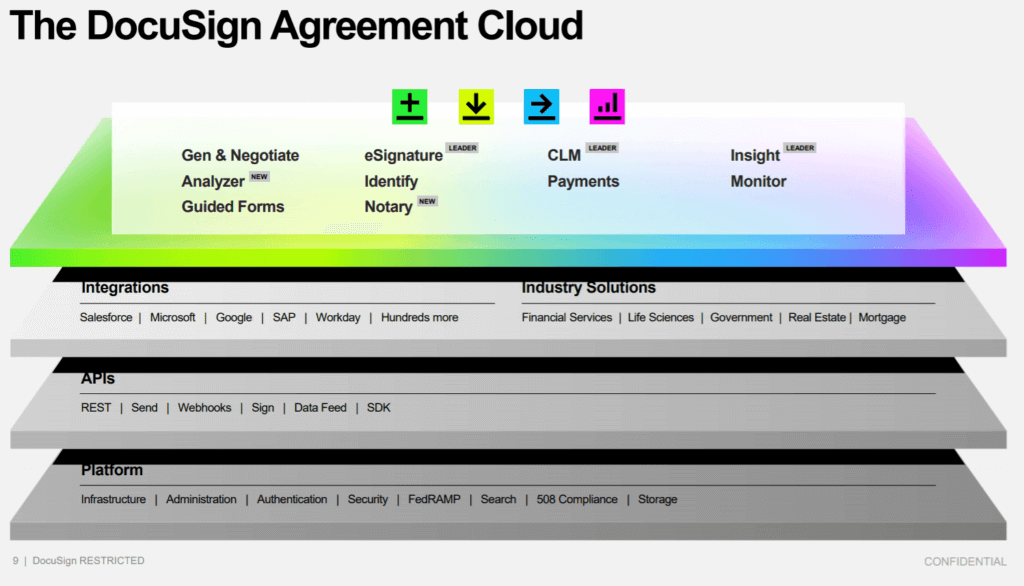
(Source: Seeking Alpha)
Sales Growth Loops
DocuSign also cleverly employs growth loops. One of the most important ones it has used are sales growth loops, which occur when the company reinvests its profits into expanding its sales channels, particularly through partners and resellers.
This approach has allowed DocuSign to amplify their reach and market penetration without solely relying on direct sales efforts. By establishing a strong network of resellers, DocuSign ensures that its products are recommended and sold by a variety of vendors, which expands their market presence and diversifies their customer base.
This strategy is supported by comprehensive training and resources to empower their resellers, enhancing the overall sales ecosystem and creating a positive feedback loop of growth and reinvestment.

(Source: DocuSign)
The integration of these strategies—sharp product differentiation and dynamic sales expansion—has not only helped DocuSign capture a dominant share of the market but has also enabled them to maintain a strong growth trajectory in the competitive landscape of digital transaction management solutions.
Common growth tactics employed by successful SaaS companies
While each SaaS company's growth story may differ, there are several common growth tactics employed by successful players in the industry.
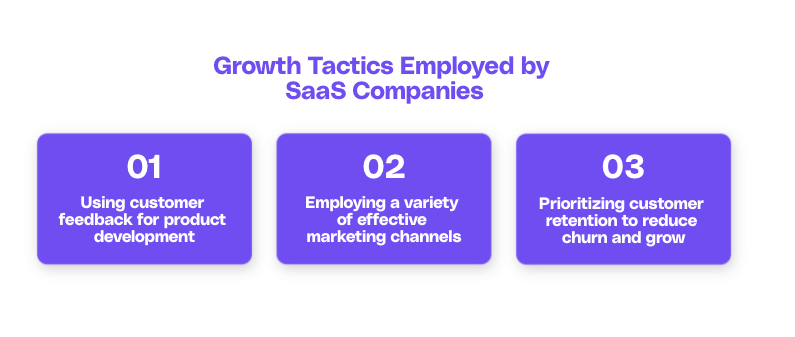
Leveraging customer feedback for product development
Successful SaaS companies recognize the value of customer feedback. By actively seeking feedback, they gain valuable insights into customer needs and pain points.
They iterate their products based on this feedback, ensuring that their offerings remain relevant and valuable to customers.
Moreover, these companies often go beyond just collecting feedback. They establish feedback loops to continuously engage with customers, involving them in the product development process.
This fosters a sense of ownership among customers while strengthening the bond between the company and its user base. By co-creating with customers, SaaS companies can develop solutions that truly resonate with their target audience.
Effective marketing strategies for SaaS
Marketing plays a pivotal role in the growth of SaaS companies. Successful companies utilize a combination of inbound and outbound marketing techniques. Some of these marketing strategies include:
| Strategy | Description |
|---|---|
| Content Creation | Developing informative and engaging materials like articles, videos, and infographics to attract and engage audiences. |
| SEO | Search Engine Optimization involves optimizing web content to increase visibility and rank higher in search engine results pages. |
| Social Media Marketing | Using platforms like Facebook, Twitter, and Instagram to promote products or services, build engagement and communicate with consumers. |
| Advertisements | Creating and placing paid content in various media formats to target and reach specific audiences to drive sales and brand awareness. |
| Referral Programs | Encouraging existing customers to refer new customers to a service or product, often with incentives for both referrer and referee. |
| Partner Programs | Collaborative initiatives where businesses work with partners or other companies to leverage each other's resources to boost growth. |
| Growth Loops | Strategies designed to use the output of a campaign or product as input to fuel further growth and create a self-sustaining marketing mechanism. |
In addition to these strategies, successful SaaS companies often invest in thought leadership initiatives, including webinars, whitepapers, and speaking engagements. These attract new customers and build credibility and trust within the market.
This proactive approach to marketing sets them apart from competitors and solidifies their reputation as innovative leaders in the SaaS space.
The role of customer retention in SaaS growth
Customer retention is vital for sustainable growth. Successful SaaS companies prioritize customer success, ensuring that customers achieve their desired outcomes with their products.
By providing exceptional customer support, offering ongoing training resources, and proactively addressing customer concerns, they reduce churn rates and foster long-lasting customer relationships.
Furthermore, leading SaaS companies understand the power of personalized customer experiences. Through segmentation and targeted communication, they tailor their interactions with customers to meet individual needs and preferences. This personalized approach not only enhances customer satisfaction but also increases loyalty and lifetime value.
By continuously engaging with customers post-sale and delivering exceptional experiences, SaaS companies can create brand advocates who renew their subscriptions and refer new business, fueling organic growth.
Challenges faced by growing SaaS companies
Despite their rapid growth, SaaS companies face several challenges along the way.
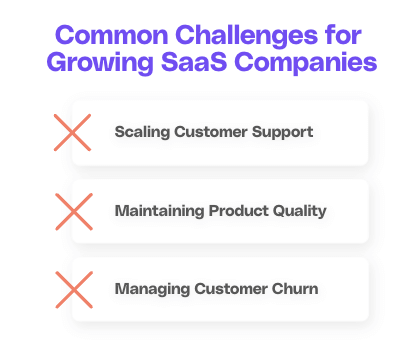
Scaling customer support with growth
As customer bases expand, scaling customer support becomes a challenge. SaaS companies must adopt scalable customer support strategies, such as self-service portals, chatbots, and knowledge bases, to effectively meet the needs of their growing customer base.
Implementing a robust customer relationship management (CRM) system can also be beneficial in managing customer interactions. This is because it ensures a personalized experience for each user.
By leveraging data analytics and automation within their CRM, SaaS companies can streamline support processes and provide timely assistance to customers at scale.
Maintaining product quality during rapid expansion
Ensuring product quality becomes increasingly challenging as SaaS companies experience rapid expansion. To tackle this challenge, successful companies prioritize quality assurance, invest in automated testing tools, and maintain strong feedback loops with customers to identify and address any potential product issues in a timely manner.
Additionally, establishing a dedicated quality assurance team that focuses on continuous testing and monitoring of the software can help maintain high standards of product quality.
Conducting regular performance reviews and incorporating user feedback into the development process are essential practices for SaaS companies looking to uphold their reputation for delivering reliable and innovative solutions.
Managing Customer Churn
As SaaS companies expand, keeping customers and reducing churn becomes a significant hurdle. Ensuring that customers remain satisfied and engaged is crucial to avoid them switching to competitors or canceling the service.
To tackle this, companies should focus on building strong customer relationships through personalized experiences and regular communication. Implementing a dedicated customer success team and utilizing predictive analytics can help identify at-risk customers and address their concerns promptly.
Enhancing the product with frequent updates and new features, alongside providing educational materials, can help maintain customer interest. Gathering and acting on customer feedback ensures that the product continues to meet their needs and expectations.
By focusing on these proactive measures, SaaS companies can effectively mitigate churn and promote long-term customer retention.
Future predictions for SaaS growth
The future of SaaS growth holds exciting possibilities. Here are a couple of emerging trends that could shape the landscape.
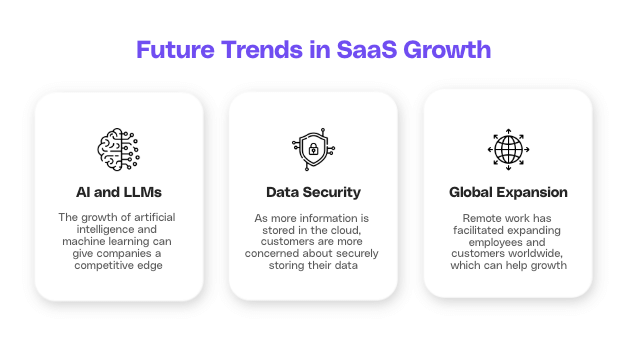
Emerging trends in SaaS
Artificial Intelligence (AI) and Machine Learning (ML) are transforming the SaaS industry. Companies that embrace these technologies can leverage the power of data analytics, automate processes, and deliver highly personalized experiences to their customers. This results in enhanced growth and customer satisfaction.
How AI and machine learning could impact SaaS growth
AI and ML have the potential to revolutionize every aspect of the SaaS business, from product development and marketing to customer support and strategic decision-making. By harnessing the power of AI and ML, SaaS companies can unlock new avenues for growth and innovation.
The role of data security in SaaS growth
As SaaS companies continue to expand and evolve, the importance of data security cannot be overstated. With the increasing amount of sensitive information stored in the cloud, customers are demanding higher levels of security to protect their data from cyber threats and breaches.
SaaS providers are investing heavily in robust security measures. These include encryption, multi-factor authentication, and regular security audits, to instill trust and confidence in their customers.
Global expansion opportunities for SaaS companies
With the rise of remote work and digital transformation initiatives worldwide, SaaS companies have unprecedented opportunities for global expansion.
By localizing their products, adapting to regional regulations, and establishing strategic partnerships in key markets, SaaS companies can tap into new customer bases and drive exponential growth.
The ability to scale internationally not only increases revenue potential but also enhances brand visibility and market competitiveness.
Unlock exponential growth with Cello
As you've seen, the fastest growing SaaS companies leverage strategic growth tactics to scale rapidly and efficiently. Now, imagine supercharging that growth by turning your users into powerful advocates with Cello. In just ~4 hours of development time, you can integrate a peer-to-peer referral program that begins paying back from day one. With Cello, sharing your product becomes frictionless and rewarding, not just for your users but for your business too. Experience a seamless integration process, flexible rewards, and robust management tools that make tracking your ROI effortless. Join the ranks of successful companies like tl;dv and see how user-led growth can transform your SaaS business. Book a demo to see Cello in action and take the first step towards viral growth.
Resources
Related Articles

Complete Guide to Sales Growth Loops
Discover the power of sales growth loops and how they drive business success.

Complete Guide to your B2B Referral Program
Want to get started with B2B referrals? Check out our complete guide to your B2B referral ...

How to use incentives to drive velocity of your growth loops
This article is written together with Wes Bush, founder and CEO of ProductLed and one of the ...

